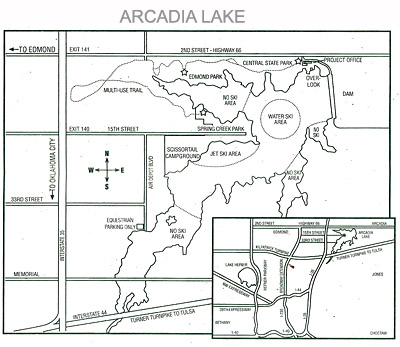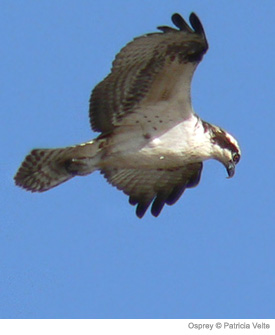LOCATION: Arcadia Lake
Contributed by Nealand Hill
Arcadia Lake is located east of I-35 in Edmond, Oklahoma. It is bounded on the north by 2nd Street and on the south by I-44/Turner Turnpike. Parks and campgrounds are access from 2nd and 15th Streets. Arcadia Lake is a water supply and recreational lake. It was built as a cooperative effort between the US Army Corps of Engineers and the City of Edmond. The normal elevation of Arcadia Lake is 1006 feet with a surface area of 1,820 acres. It is surrounded by 26 miles of shoreline. The lake, parks and camping areas are all fee-based ($6 per day / per car). (Download PDF / printable map)
 All the roads around the lake are paved. The park is always clean and well maintained. Birding is very good on and around the lake during any season. There are limited areas for mudflats since the lake level remains fairly constant. However, the western edge of the overnight camping area at Edmond Park provides areas for some shorebirds.
All the roads around the lake are paved. The park is always clean and well maintained. Birding is very good on and around the lake during any season. There are limited areas for mudflats since the lake level remains fairly constant. However, the western edge of the overnight camping area at Edmond Park provides areas for some shorebirds.
Spring and Summer: You will see large numbers of ducks, mergansers and grebes. Mallards, Green-winged Teal, Redhead, American Wigeon, Lesser Scaup, Bufflehead, and Ruddy Ducks are the most common. Hooded and Common Mergansers; Pied-billed, Horned and Eared Grebes can be found. Warblers include Black-and-White, Wilson’s, Orange-crowned, Common Yellowthroat, American Redstarts, Prothonotary, Nashville, Yellow, Kentucky, and Louisiana Waterthrush. Ruby-throated Hummingbirds are numerous. Chipping, Lark, Grasshopper and other sparrows are also around as are Orchard and Baltimore Orioles. Wood Thrush can be seen. Look for Mississippi Kites, Yellow-billed Cuckoo, Eastern and Western Kingbirds, Blue-gray Gnatcatcher, Scissor-tailed Flycatcher, Indigo and Painted Buntings, American Goldfinch, House Finch, Blue Grosbeaks, Gray Catbird, and Dickcissel. Vireo sightings include White-eyed, Yellow-throated, Bell’s, Red-eyed, and Warbling.
Forster’s and Common Terns, Great Egret, Little Blue Heron, Green Heron, Snowy Egret, Yellow-crowned and Black-crowned Night-Heron, and Cattle Egret. Hawks include Cooper’s Red-shouldered, Red-tailed, Swainson’s; also found are American Kestrels, Turkey Vultures, Common Nighthawks, Chimney Swift, Cliff and Barn Swallows, and Purple Martin.
 Fall and Winter: The Bald Eagle is the best bird to look for during winter months. Arcadia Lake sponsors an Eagle Watch on the first weekend in January with discounted admission. Ospreys are also seen over the lake during both spring and fall migrations. Also watch for Merlin and Sharp-shinned Hawks, Golden- and Ruby-crowned Kinglets, Cedar Waxwings, Spotted Towhee; White-throated, Harris’s, Lincoln’s and Song Sparrows. Pine Siskin, Dark-eyed Junco, White-crowned, Fox and American Tree Sparrows, Double-crested Cormorant are abundant during the winter months and roost in high numbers during the late afternoon.
Fall and Winter: The Bald Eagle is the best bird to look for during winter months. Arcadia Lake sponsors an Eagle Watch on the first weekend in January with discounted admission. Ospreys are also seen over the lake during both spring and fall migrations. Also watch for Merlin and Sharp-shinned Hawks, Golden- and Ruby-crowned Kinglets, Cedar Waxwings, Spotted Towhee; White-throated, Harris’s, Lincoln’s and Song Sparrows. Pine Siskin, Dark-eyed Junco, White-crowned, Fox and American Tree Sparrows, Double-crested Cormorant are abundant during the winter months and roost in high numbers during the late afternoon.
Year round: American White Pelican, Great Blue Heron, Canada Goose, Red-tailed Hawk, Wild Turkey, Northern Bobwhite, American Coot, Ring-billed Gull, Rock Pigeon, Mourning Dove, White-winged Dove, Roadrunner, Great Horned Owl, Barred Owl, Eastern Screech Owl, Belted Kingfisher, Pileated, Red-head and Red-bellied Woodpeckers, Northern Flicker, Downy and Hairy Woodpeckers, Loggerhead Shrike, Blue Jay, American Crow, Tufted Titmouse, Carolina and Bewick’s Wrens, Eastern Bluebird, American Robin, Northern Mockingbird, Eastern Phoebe, Spotted Towhee, Northern Cardinal, Eastern Meadowlark, Red-winged Blackbird, House Sparrow.
Birding Observation Locations:
Spring Creek Park (15th Street): Turn left at the first paved road after the admissions gate at Spring Creek Park. This road follows the shoreline and provides a good look at ducks, cormorant, kingfisher, grebe. Watch for Orchard and Baltimore Orioles near the picnic areas along this road. The eastern edge of Spring Creek Park overlooks the beach area and provides an excellent view of Common and Red-breasted Mergansers, pelicans and gulls. Barred Owls can be spotted late in the day.
Edmond Park (2nd Street): This park is closed from October to April so it’s worth visiting the area in spring since the birds have not been disturbed for many months. The shoreline at the west end of the park is excellent for viewing Osprey, Double-crested Cormorant, Red-headed Woodpeckers, shorebirds, ducks and geese.
Central State Park (2nd Street): This is a great location for Painted Buntings during the summer months. Also listen for Indigo Buntings, Field Sparrows, warblers, and wrens. The Cottonwood Campground is a good location for many species even during peak camping season. From the main entrance into Central State Park, be sure to take the first left and tour the picnic pavilion areas. Painted Buntings are commonly found along this road.
RELATED LINKS:
-
Kaitlyn Patton, Girl Scout Troop 3515, Gold Award project in progress. She saw a problem in our society that not many people– mainly children — go outdoors anymore and that many people don’t know local wildlife. Her goal was to help bring awareness but also to help the environment and surrounding areas. To help counteract this problem, she decided for her project to build a bird watching wall at Arcadia Lake. This wall consists of 8 panels and has new bird houses on the opposite side. There is also a link for an app, Merlin Bird ID, that will help visitors identify bird calls and learn about the local birds in the area.
